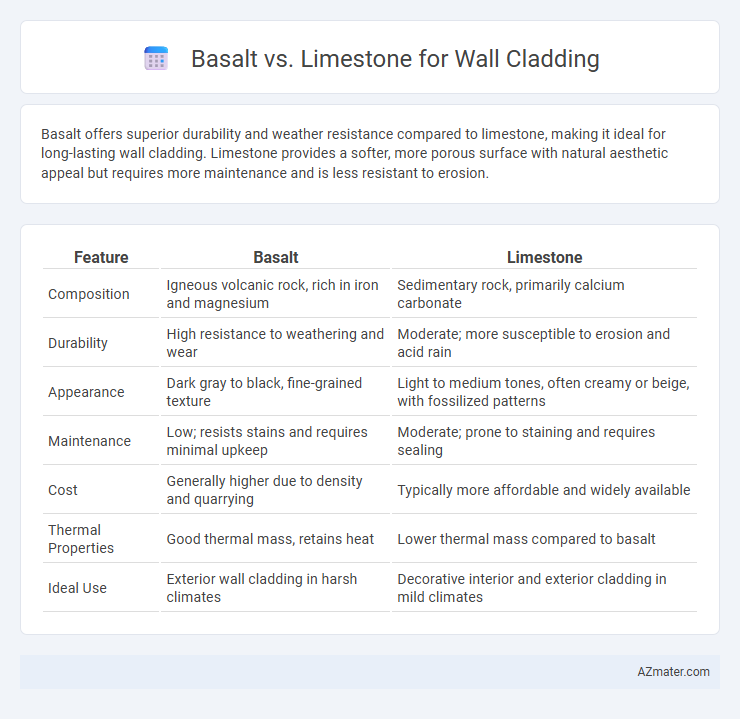Basalt offers superior durability and weather resistance compared to limestone, making it ideal for long-lasting wall cladding. Limestone provides a softer, more porous surface with natural aesthetic appeal but requires more maintenance and is less resistant to erosion.
Table of Comparison
| Feature | Basalt | Limestone |
|---|---|---|
| Composition | Igneous volcanic rock, rich in iron and magnesium | Sedimentary rock, primarily calcium carbonate |
| Durability | High resistance to weathering and wear | Moderate; more susceptible to erosion and acid rain |
| Appearance | Dark gray to black, fine-grained texture | Light to medium tones, often creamy or beige, with fossilized patterns |
| Maintenance | Low; resists stains and requires minimal upkeep | Moderate; prone to staining and requires sealing |
| Cost | Generally higher due to density and quarrying | Typically more affordable and widely available |
| Thermal Properties | Good thermal mass, retains heat | Lower thermal mass compared to basalt |
| Ideal Use | Exterior wall cladding in harsh climates | Decorative interior and exterior cladding in mild climates |
Introduction to Basalt and Limestone Wall Cladding
Basalt wall cladding offers exceptional durability and a striking dark appearance, making it ideal for modern architectural designs that require strength and weather resistance. Limestone, characterized by its lighter tones and natural sedimentary patterns, provides a classic aesthetic with excellent thermal insulation properties suitable for both interior and exterior applications. Both materials enhance building facades with natural stone appeal, but basalt stands out for structural toughness while limestone excels in versatility and historical charm.
Geological Formation and Properties
Basalt, an extrusive igneous rock formed from rapid cooling of lava, exhibits high density, durability, and resistance to weathering, making it ideal for wall cladding in harsh environments. Limestone, a sedimentary rock primarily composed of calcite, forms through the accumulation of marine organisms' skeletal fragments and offers a softer, more porous surface with excellent workability and natural aesthetic variations. The geological origin of basalt results in a fine-grained, dark appearance and strong structural integrity, whereas limestone's sedimentary layer formation yields a lighter color palette with potential for fossil imprints and moderate resistance to acids.
Aesthetic Appeal and Design Versatility
Basalt offers a sleek, dark, and contemporary aesthetic with a fine-grained texture ideal for modern wall cladding designs, while limestone provides a warm, natural look with soft earthy tones and subtle variations that enhance traditional and classic styles. Basalt's uniformity and ability to be polished or honed create a minimalist and elegant finish, whereas limestone's porous surface allows for intricate carving and a rustic charm that suits diverse architectural themes. Both stones offer versatile installation options, but basalt tends to work better in urban, industrial, or minimalist designs, whereas limestone excels in heritage, Mediterranean, and rustic applications.
Durability and Weather Resistance
Basalt offers superior durability and weather resistance compared to limestone, making it an excellent choice for wall cladding in harsh climates. Its dense, volcanic origin provides high compressive strength and resistance to abrasion, frost, and chemical weathering. Limestone, while aesthetically pleasing and easier to work with, tends to be more porous and susceptible to erosion and acid rain damage over time.
Installation Process and Ease of Handling
Basalt wall cladding requires specialized cutting tools due to its hardness and density, making the installation process more labor-intensive and time-consuming compared to limestone. Limestone's softer composition allows for easier cutting, shaping, and fastening, resulting in a quicker and more manageable installation experience. Both materials demand precise handling, but limestone offers greater ease of handling and flexibility, reducing labor costs and installation complexity.
Maintenance Requirements and Longevity
Basalt offers exceptional durability and low maintenance due to its dense, non-porous structure, resisting weathering and staining effectively in wall cladding applications. Limestone requires more regular upkeep, including sealing and careful cleaning, to prevent surface erosion and staining caused by its porous nature and susceptibility to acidic rain. Basalt's longevity surpasses limestone, making it a superior choice for long-term exterior cladding with minimal maintenance demands.
Cost Comparison and Budget Considerations
Basalt wall cladding generally incurs higher installation and material costs compared to limestone due to its density and durability, impacting budget allocation significantly. Limestone, being more abundant and easier to work with, offers a cost-effective alternative for large-scale projects or tight budgets without compromising aesthetic appeal. Project planners prioritize limestone when aiming to balance quality and expenditure, while basalt is favored for long-term durability despite the initial financial outlay.
Environmental Impact and Sustainability
Basalt offers superior environmental benefits for wall cladding due to its natural abundance and low embodied energy compared to limestone, which typically undergoes more intensive quarrying and processing. The durability and weather resistance of basalt reduce long-term maintenance and replacement needs, enhancing sustainability. Limestone's higher carbon footprint from calcination releases more CO2 during production, making basalt a more eco-friendly choice for sustainable building projects.
Best Applications for Basalt and Limestone Cladding
Basalt is ideal for wall cladding in exterior applications requiring high durability, weather resistance, and a modern aesthetic, making it suitable for commercial buildings and urban facades. Limestone excels in interior wall cladding where a softer texture and warm, natural appearance are desired, often used in residential spaces, historical restorations, and decorative feature walls. Both stones provide unique visual appeal, with basalt offering a sleek, dark finish and limestone delivering earthy tones and varied textures.
Choosing the Right Stone for Your Wall Cladding Project
Basalt offers exceptional durability and a sleek, modern aesthetic with its dark, fine-grained texture, making it ideal for high-traffic or exterior wall cladding requiring weather resistance. Limestone provides a softer, warmer appearance with a wide range of natural colors and textures, better suited for interior walls or projects seeking a classic, elegant look with easier workability. Selecting between basalt and limestone depends on environmental exposure, desired aesthetic, maintenance needs, and budget, ensuring your wall cladding achieves both functionality and visual appeal.

Infographic: Basalt vs Limestone for Wall Cladding
 azmater.com
azmater.com